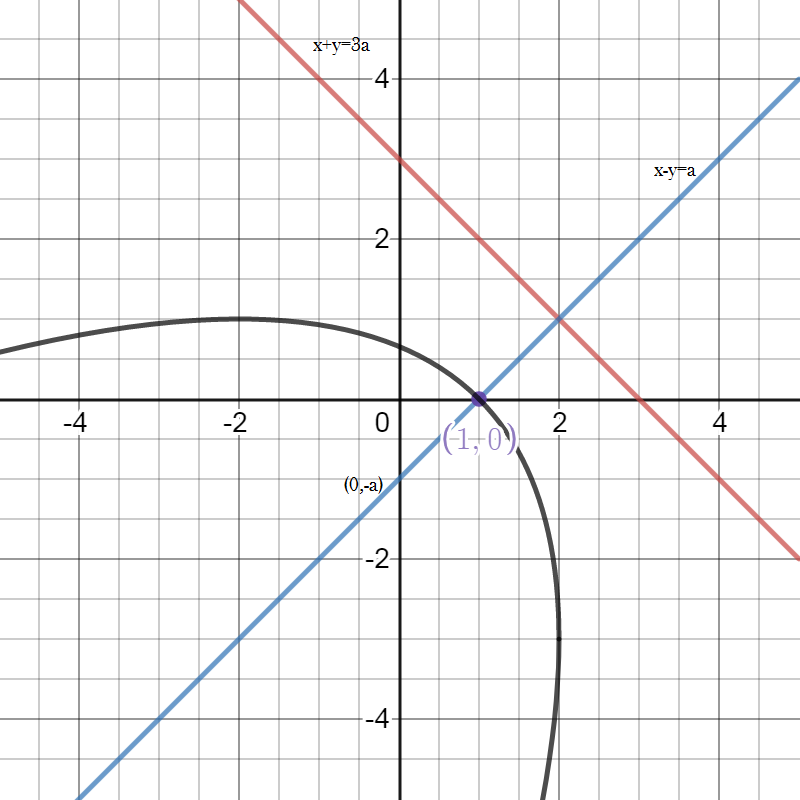
The vertex of a parabola is (a, 0) and the directrix is x + y = 3a. The equation of the parabola is
A. ${x^2} - 2xy + {y^2} + 6ax + 10ay - 7{a^2} = 0$
B. ${x^2} + 2xy + {y^2} + 6ax + 10ay + 2{a^2} = 0$ = 0
C. \[{x^2} + 2xy + {y^2} + 6ax + 10ay = 2{a^2}\]
D. None of these
Answer
576.9k+ views
Hint: The axis of the parabola is perpendicular to the directrix and passes through the vertex. The equation of the directrix is given. Hence one can easily find the equation of the axis of the parabola.
Next, find the focus S (Note that vertex is the midpoint of foot of directrix and focus).
Now by definition, from any point P on the parabola, if we draw $\overleftrightarrow {{\text{PM}}}$ perpendicular to the directrix,
then ${PS}^{2}={PM}^2$
Complete step-by-step answer:

Given, the vertex is at (a, 0) and the directrix is x + y = 3a
The slope of the line perpendicular to the directrix x + y= 3a is 1
Since, the axis of the parabola is perpendicular to the directrix, the equation of the axis is $x - y = c$ , say. Since the axis passes through the vertex (a, 0), we substitute x=a, y=0 in the equation $x - y = c$.
$
\Rightarrow a - 0 = c \\
\Rightarrow a = c \\
$
∴ The equation of the axis is $x - y = a$
Now, solving the equations of the directrix and the axis ,we get the foot of the directrix (2a,a)
Again, we know vertex is the midpoint of the foot of the directrix and focus.
∴ focus is at S≡(0,−a)
Next, from any point P on the parabola, draw $\overleftrightarrow {{\text{PM}}}$ perpendicular to the directrix.
From the definition of parabola, we know ${PS}^{2}={PM}^2$
\[
{(x - 0)^2} + {(y + a)^2} = {\left( {\dfrac{{x + y - 3a}}{{\sqrt 2 }}} \right)^2} \\
{\text{On simplifying we get,}} \\
\Rightarrow 2{x^2} + 2{y^2} + 4ay + 2{a^2} = {x^2} + {y^2} + 9{a^2} + 2xy - 6ax - 6ay \\
\Rightarrow {x^2} + {y^2} - 2xy + 6ax + 10ay - 7{a^2} = 0 \\
\]
Hence, option (A) is correct.
Note: Note that, from any point P on the parabola, if we draw $\overleftrightarrow {{\text{PM}}}$ perpendicular to the directrix.
then ${PS}^{2}={PM}^2$ , where S is the focus of the parabola.
Next, find the focus S (Note that vertex is the midpoint of foot of directrix and focus).
Now by definition, from any point P on the parabola, if we draw $\overleftrightarrow {{\text{PM}}}$ perpendicular to the directrix,
then ${PS}^{2}={PM}^2$
Complete step-by-step answer:

Given, the vertex is at (a, 0) and the directrix is x + y = 3a
The slope of the line perpendicular to the directrix x + y= 3a is 1
Since, the axis of the parabola is perpendicular to the directrix, the equation of the axis is $x - y = c$ , say. Since the axis passes through the vertex (a, 0), we substitute x=a, y=0 in the equation $x - y = c$.
$
\Rightarrow a - 0 = c \\
\Rightarrow a = c \\
$
∴ The equation of the axis is $x - y = a$
Now, solving the equations of the directrix and the axis ,we get the foot of the directrix (2a,a)
Again, we know vertex is the midpoint of the foot of the directrix and focus.
∴ focus is at S≡(0,−a)
Next, from any point P on the parabola, draw $\overleftrightarrow {{\text{PM}}}$ perpendicular to the directrix.
From the definition of parabola, we know ${PS}^{2}={PM}^2$
\[
{(x - 0)^2} + {(y + a)^2} = {\left( {\dfrac{{x + y - 3a}}{{\sqrt 2 }}} \right)^2} \\
{\text{On simplifying we get,}} \\
\Rightarrow 2{x^2} + 2{y^2} + 4ay + 2{a^2} = {x^2} + {y^2} + 9{a^2} + 2xy - 6ax - 6ay \\
\Rightarrow {x^2} + {y^2} - 2xy + 6ax + 10ay - 7{a^2} = 0 \\
\]
Hence, option (A) is correct.
Note: Note that, from any point P on the parabola, if we draw $\overleftrightarrow {{\text{PM}}}$ perpendicular to the directrix.
then ${PS}^{2}={PM}^2$ , where S is the focus of the parabola.
Recently Updated Pages
Why are manures considered better than fertilizers class 11 biology CBSE

Find the coordinates of the midpoint of the line segment class 11 maths CBSE

Distinguish between static friction limiting friction class 11 physics CBSE

The Chairman of the constituent Assembly was A Jawaharlal class 11 social science CBSE

The first National Commission on Labour NCL submitted class 11 social science CBSE

Number of all subshell of n + l 7 is A 4 B 5 C 6 D class 11 chemistry CBSE

Trending doubts
What is meant by exothermic and endothermic reactions class 11 chemistry CBSE

10 examples of friction in our daily life

One Metric ton is equal to kg A 10000 B 1000 C 100 class 11 physics CBSE

1 Quintal is equal to a 110 kg b 10 kg c 100kg d 1000 class 11 physics CBSE

Difference Between Prokaryotic Cells and Eukaryotic Cells

What are Quantum numbers Explain the quantum number class 11 chemistry CBSE




